November 20. MADURAI "Religious Life at the Sri Meenakshi Temple" In the night I got a bit cold, probably as we were reaching the higher elevations, but it was a manageable night overall. We just slept in our clothes, used our sleeping pads for some added comfort, and jackets for pillows. The train rolled into Madurai around 5:00 in the morning. Daylight was just breaking. The town was quiet but there was still a line of tuk tuks in front of the station. Naturally they wanted a premium for the early hour but our target hotel wasn't far so we started to walk. As we stepped out onto the road in front of the station we were struck by how dirty it was and we were suddenly put off of walking to the hotel. With our big packs on we felt rather conspicuous as well. We hopped into a tuk tuk and asked to be dropped off at the Padman hotel. Our first inquiry into rates was higher than expected so we left and waited for our tuk tuk to lea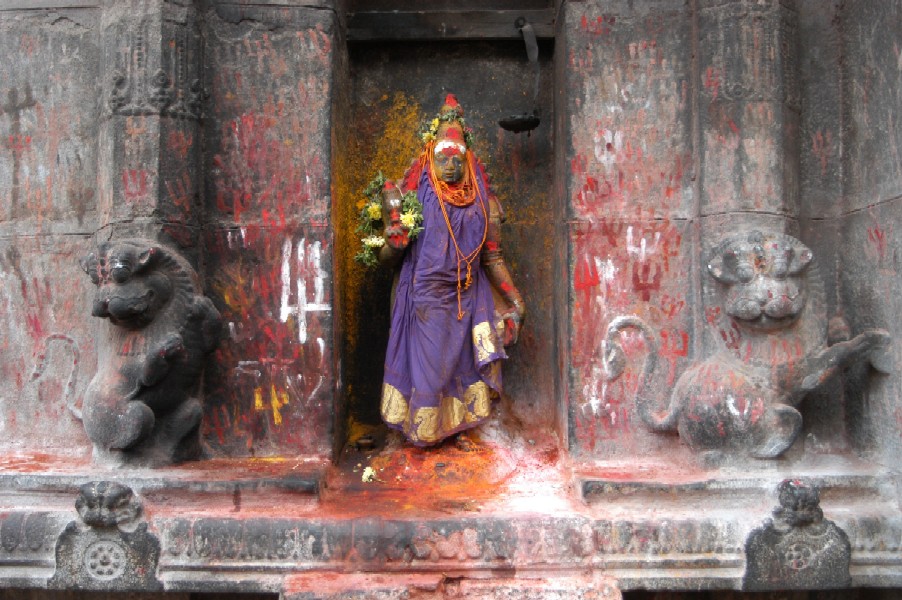 ve before trying again. We were then offered a better rate. Our room was on one of the upper floors and overlooked an old dilapidated water tank. The sky was a bit hazy and gray but we could see the towers of the Shri Meenakshi- Sunareshwarar Temple in the middle of town. Little lights were still lit from nighttime but the detail of the gloriously colorful and ornate statues that adorned the towers were slowly coming into focus. In a bizarre way the image reminded me of pictures I had seen of the ruins of Angkor Wat or the pyramids of Central America, dramatic structure rising out of the dense green foliage. But, in this case the surrounding "jungle" wasn't green but rather a hodgepodge of modern concrete construction that had grown as high as it could without total eclipsing the great temple. ve before trying again. We were then offered a better rate. Our room was on one of the upper floors and overlooked an old dilapidated water tank. The sky was a bit hazy and gray but we could see the towers of the Shri Meenakshi- Sunareshwarar Temple in the middle of town. Little lights were still lit from nighttime but the detail of the gloriously colorful and ornate statues that adorned the towers were slowly coming into focus. In a bizarre way the image reminded me of pictures I had seen of the ruins of Angkor Wat or the pyramids of Central America, dramatic structure rising out of the dense green foliage. But, in this case the surrounding "jungle" wasn't green but rather a hodgepodge of modern concrete construction that had grown as high as it could without total eclipsing the great temple.
Our room was quiet, clean and pretty comfortable. We got cleaned up and then crashed in bed until late morning. After dabbling in a bit of cable TV we mobilized ourselves to go out again. We ate breakfast at our hotel's rooftop restaurant looking out at the nice views towards the temple. Our first task was to return to the station to sort out tickets to our next destination, Trichy. We had hoped for a train early the following day but, unfortunately, they were sold out until the evening. That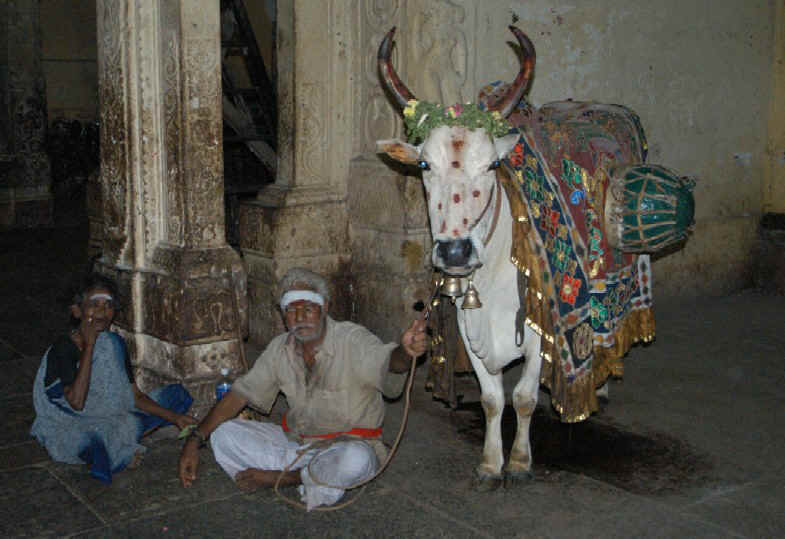 meant we would have to pay another half day at our hotel or find a place to hang out all day. A peculiar arrangement with many Indian hotels was that they charged you for every 24 hours of your stay. Since we had checked in around 5:30 in the morning we technically had to be out by 5:30 the following morning. If we could have gotten an early morning train we could have checked and stowed our bags until the train departure but with a whole day to kill we ended up keeping the room. It as in Madurai that we bought an Indian train schedule, a large magazine sized book with all of the major train timetables. We figured that we had to start planning ahead a bit more so we didn't encounter more sold out trains. We also used one of the pay-as-you-go phone stalls in front of the station to make a hotel reservation for Trichy. As we stood there I noticed a pair of old woman sitting on the sidewalk. They were dressed with only a tattered sari, no shirt underneath, which frequently exposed their sagging breasts. They were disheveled and looked like they hadn't bathed in a while. I didn't know what to make of them. India was conservative as far as women's dress goes so what did their clothing mean. Where they too poor to buy anything more or was this degraded appearance a reflection of their meager status. It tugged at my insides. meant we would have to pay another half day at our hotel or find a place to hang out all day. A peculiar arrangement with many Indian hotels was that they charged you for every 24 hours of your stay. Since we had checked in around 5:30 in the morning we technically had to be out by 5:30 the following morning. If we could have gotten an early morning train we could have checked and stowed our bags until the train departure but with a whole day to kill we ended up keeping the room. It as in Madurai that we bought an Indian train schedule, a large magazine sized book with all of the major train timetables. We figured that we had to start planning ahead a bit more so we didn't encounter more sold out trains. We also used one of the pay-as-you-go phone stalls in front of the station to make a hotel reservation for Trichy. As we stood there I noticed a pair of old woman sitting on the sidewalk. They were dressed with only a tattered sari, no shirt underneath, which frequently exposed their sagging breasts. They were disheveled and looked like they hadn't bathed in a while. I didn't know what to make of them. India was conservative as far as women's dress goes so what did their clothing mean. Where they too poor to buy anything more or was this degraded appearance a reflection of their meager status. It tugged at my insides.
In the afternoon we set from the hotel and just walked through town, past the massive temple, and over to the Thirumalai Naya k Palace. The palace was meant to house a museum but we found nobody at the ticket office. A door opened out from the office into the a large rectangular courtyard so we slipped through to find someone that could help us. The courtyard was massive and empty. Some rather poor restoration work had been done on parts so it wasn't anything exceptional. Some people sleeping by the front door perked up when they saw us, gesticulating wildly that we shouldn't be inside. We explained that we wanted to buy a ticket but, for some reason, they weren't selling tickets that day. They let us out the front door and there we noticed a sign indicating the palace was closed. It wasn't next to the ticket office or the sign pointing to the ticket office but it was there. k Palace. The palace was meant to house a museum but we found nobody at the ticket office. A door opened out from the office into the a large rectangular courtyard so we slipped through to find someone that could help us. The courtyard was massive and empty. Some rather poor restoration work had been done on parts so it wasn't anything exceptional. Some people sleeping by the front door perked up when they saw us, gesticulating wildly that we shouldn't be inside. We explained that we wanted to buy a ticket but, for some reason, they weren't selling tickets that day. They let us out the front door and there we noticed a sign indicating the palace was closed. It wasn't next to the ticket office or the sign pointing to the ticket office but it was there.
From the palace we hopped into a tuk tuk and rode across town to the Tamukkan Palace, home to the Gandhi and government museums. It housed a wordy exhibit of India's freedom fight, beginning with the arrival of the first Europeans. It offered some good information but it became time consuming to read everything and we found ourselves skimming a bit towards the end. The exhibit ended in a small room painted in solid black. In the middle was a small case displaying the blood-stained dhoti (white cloth worn by men) that was worn by Mahatma Gandhi on the day he was assassinated, January 30th, 1948. One of the greatest figures of the 20th century, Gandhi represented a determined but passive resistance to India's colonial rule and fought for the rights of India's harijans, the women and untouchables overlooked by society. He also pushed for fair treatment of Muslim Indians and sought to end violence between the Hindu and Muslim communities, leading to his assassination by a Hindu zealot. Seeing his bloodstained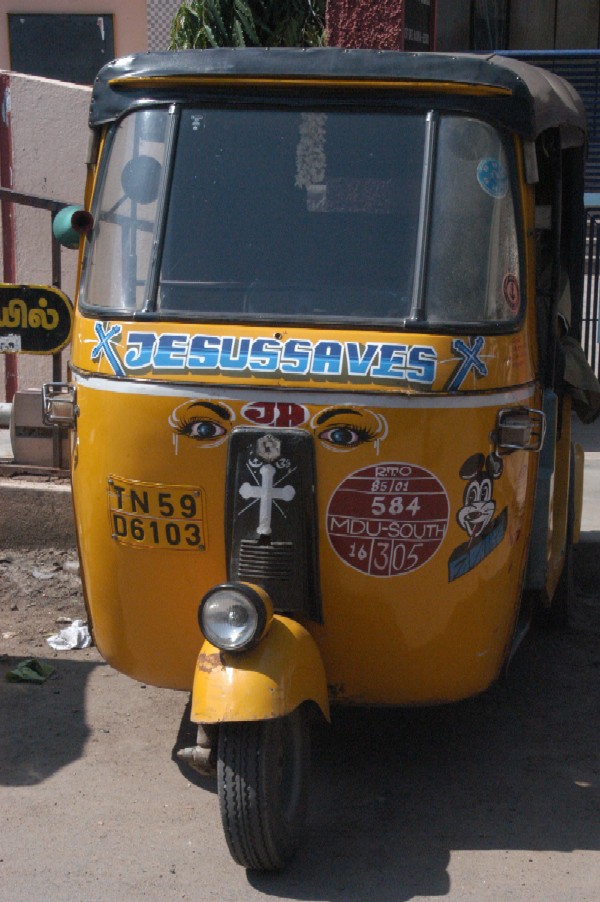 dhoti was chilling. dhoti was chilling.
When we finished with the museum our same tuk tuk driver was waiting for us. For some reason he was driving with a friend and they both squished together on the single-sized front seat, which looked odd. He whizzed us back across town and dropped us at the east entrance to the temple. We were both wearing tevas, without socks of course, and it wasn't until we stepped out of the tuk tuk that we were reminded that we needed to remove our shoes before entering the temple. Other travelers had advised that we carry our shoes with us, which is what we had done in Sri Lanka. They had been hounded at various temples to leave their shoes and pay someone to watch them but later observed the local people carrying their own shoes and resisted the harassment from the shoe touts. We were in Tamil Nadu now but, like Kerela, the people were not very aggressive. In general there was a laid back feeling to South India that dispelled all of those rumors of horrible hassles. The man watching over the shoe check booth did ask us about our shoes but we just indicated that we would carry them. It also meant we could leave from any of the other exits and avoid back tracking to the farthest  point. So, with our shoes tucked into a bag we entered through the gate an found ourselves in a cavernous hallway, flanked on both sides with colorful kiosks selling everything from disco deities (Hindu deities represented with multicolored blinking lights) to cooking supplies. Many of the stalls did specialize in religious items -- statues, deity stickers, and a fashionable array of bindis. Bindis are the colored dots worn on the forehead of women. They were originally red and worn primarily by married women but today they extend to women of all ages, married or unmarried, as well as non-Hindu women. The mark was meant to protect the woman with the blessed symbol of Uma (Parvati) and signified female strength but has also become a bit of a fashion statement in modern terms. They came in so many colors and shapes, some glittering, that it almost made me want to put one on but I had to remember the other foreigners I'd seen wearing the bindi and consider how odd they seemed at the time. point. So, with our shoes tucked into a bag we entered through the gate an found ourselves in a cavernous hallway, flanked on both sides with colorful kiosks selling everything from disco deities (Hindu deities represented with multicolored blinking lights) to cooking supplies. Many of the stalls did specialize in religious items -- statues, deity stickers, and a fashionable array of bindis. Bindis are the colored dots worn on the forehead of women. They were originally red and worn primarily by married women but today they extend to women of all ages, married or unmarried, as well as non-Hindu women. The mark was meant to protect the woman with the blessed symbol of Uma (Parvati) and signified female strength but has also become a bit of a fashion statement in modern terms. They came in so many colors and shapes, some glittering, that it almost made me want to put one on but I had to remember the other foreigners I'd seen wearing the bindi and consider how odd they seemed at the time.
Off to the north of this colorful temple shopping arcade was the entrance to an art museum, housed in the temples grand "thousand-pillared" hall. Before it got too late we bought a ticket and took a look around. It was full of all sorts of statues made of bronze and stone, including a dramatic Nataraja (dancing Shiva) positioned at the end, between two columns of pillars. On the far side were some colorfully painted boards depicting stories from the Hindu epics. Exiting back the way we had come we cross the shopping arcade and pass through a small courtyard with a massive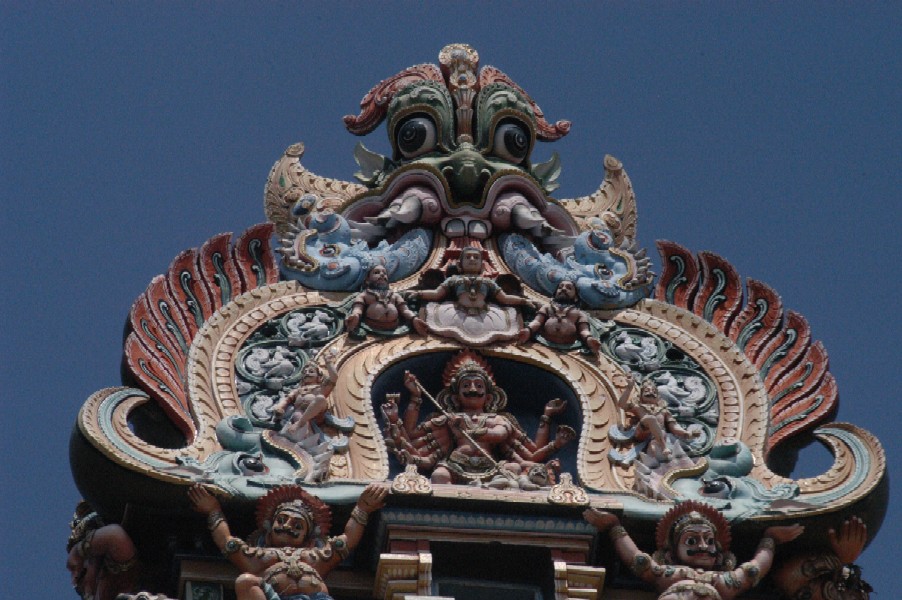 yoni-lingam statue enshrined in the middle. The yoni-lingam symbol is common throughout Hinduism. The lingam, or male phallic symbol of Lord Shiva, emerging from the yoni, or female symbol of Shiva's consort, makes for a somewhat shocking image for those new to Hinduism but definitely conveys that sense of union between masculine and feminine. yoni-lingam statue enshrined in the middle. The yoni-lingam symbol is common throughout Hinduism. The lingam, or male phallic symbol of Lord Shiva, emerging from the yoni, or female symbol of Shiva's consort, makes for a somewhat shocking image for those new to Hinduism but definitely conveys that sense of union between masculine and feminine.
On the far side of the courtyard we entered another large hall filled with more shops. Shops specializing in bracelets were some of the most colorful with an array of metal and plastic multicolored bracelets stacked high. The interior of the temple seemed to make a kind of "U" shape with the two hallways leading to the main shrine area and the Tank of Golden lotuses, which connected via a smaller passageway. We passed through the stalls and turned right to reach the tank, a deep pool used for washing before prayer. It was in need of some attention. Algae were taking over what little bit of water was left at the bottom. It was surrounded by some incongruous red and white striped concrete steps. From around that tank we got our first look, from the inside, at the towering gopuras. They were a distinct feature of southern India's Dravidian architecture, narrow pyramid-like structures that were exploding with colorfully animated stucco images of Hindu deities. According to our Rough 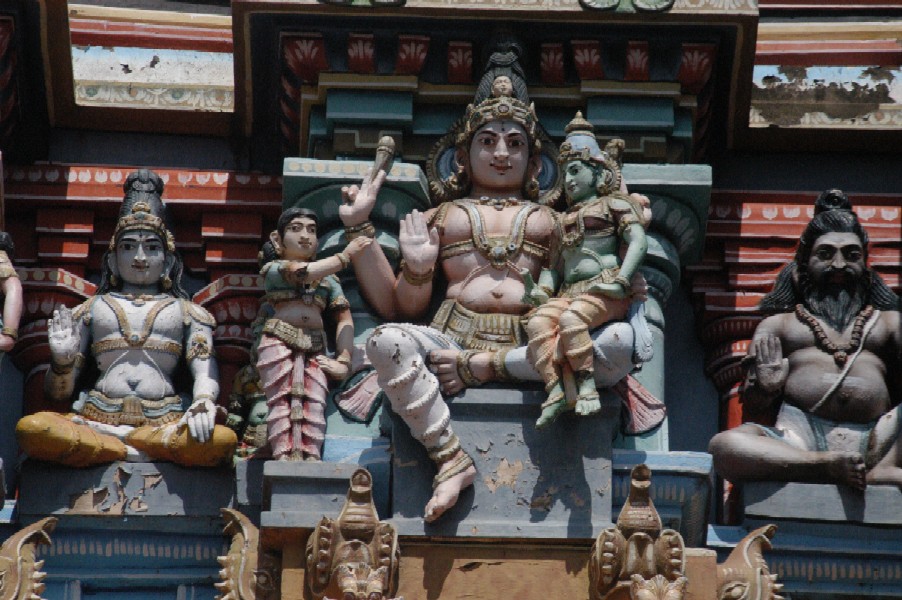 Guide there were some 33,000 sculptures in the complex and they needed to be repainted every ten years to survive. There were twelve gopuras scattered across the temple rooftops, the highest reaching nearly 50 meters. Guide there were some 33,000 sculptures in the complex and they needed to be repainted every ten years to survive. There were twelve gopuras scattered across the temple rooftops, the highest reaching nearly 50 meters.
Sitting along the top of the tank we stopped to take in the hum of activity. The walls in the tank courtyard were colorfully painted with stories of Shiva's miracles in Madurai. One section was being skillfully repainted by an artisan. At the far corner of the tank courtyard was the entrance that most people used to access the temple. It was through the large gopura on the south side. Beyond the tower was a kind of empty roadway that separated the outer wall from the inner wall. Another doorway brought people into the tank courtyard. The weather had turned gray we started to get some sprinkling but as evening drew near the number of people making their pilgrimage through the temple increased. A young woman sat down next to me and started up idle conversation (How are you? Where are you from?). I knew there was an ulterior motive but went along with the chit chat because she was very pleasant. Eventually she got around to showing me the jewelry she was selling. I politely declined but she sat for a bit longer and gave a couple of more tries before saying "good-bye". Like the people in Kerela, the people in Tamil Nadu had a pretty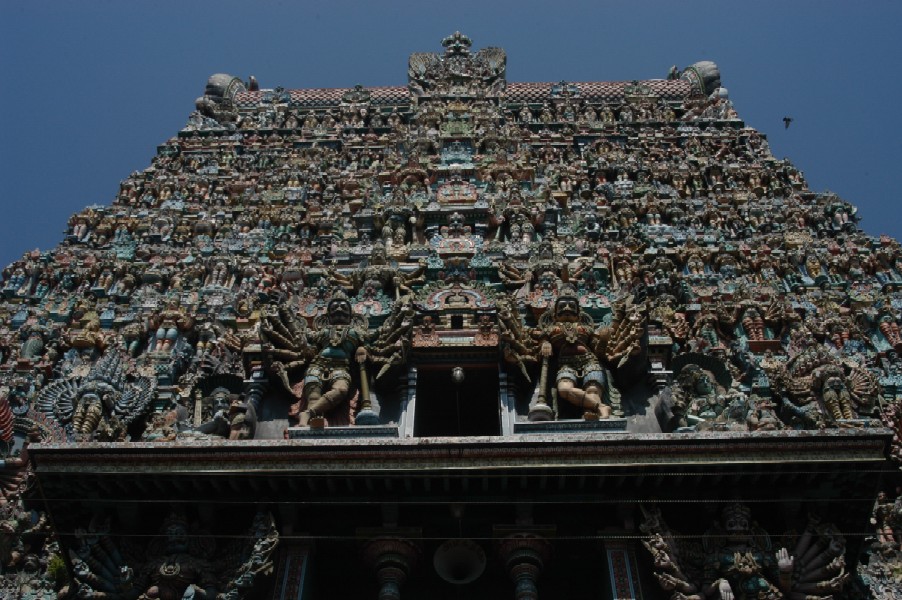 easy-going demeanor. I was a little surprised to be hit up inside the temple but with the buzz of other commercial activity it made sense. easy-going demeanor. I was a little surprised to be hit up inside the temple but with the buzz of other commercial activity it made sense.
On the far side of the tank from where we had been sitting and in line with the flow of traffic into the temple we found a ticket kiosk where we purchased our photo ticket. Locals made other donations through the same windows. Farther inside, a neon sign marked the way to the main shrines. The shopping arcade, ticket windows and neon signs gave the temple a sort of amusement park feeling. Adding to that was the grimy sensation I had wherever I thought about my bare feet. It made me remember walking around the Santa Cruz Beach Boardwalk when I was a teenager. Considering that everyone removed their shoes before entering the temple it wasn't particularly clean. Most of the walk ways were exposed to the elements and many of the worshippers arrived barefooted so they tended to track the street grime into the temple complex anyway. We watched a group of French speaking tourist traipse through with little medical booties over their feet. I didn't like being barefoot but they did look especially ridiculous, only added to by their inappropriately skimpy western attire. But the amusement park analogy doesn't capture the vibrant and religious atmosphere that was so  evident at the Meenakshi Temple. The whole place just teemed with life as people prayed at various points along their path. It felt like a city within a city. The neon lights and commercial kiosks just added to this surreal world of Hindu devotion. evident at the Meenakshi Temple. The whole place just teemed with life as people prayed at various points along their path. It felt like a city within a city. The neon lights and commercial kiosks just added to this surreal world of Hindu devotion.
The Meenakshi Temple was built in 1560, during the Nayak period, and even the disco deities couldn't detract from the temple's historical aura. Meenakshi is an incarnation of Devi, Shiva's wife. The matrix of some thousands or even millions of Hindu deities is mind boggling at best. Some of my Indian history reading indicated that the various deities of the once separate kingdoms have been incorporated into Hinduism over time. Something like Christianity's incorporation of the pagan evergreen tree into a Christmas symbol with new Christian meaning. As Hinduism spread and encountered new people's their gods became incarnations of the existing Hindu gods, probably allowing for a much more passive cultural absorption. So, while Devi is part of the main Hindu pantheon and is referred to across the country, Meenakshi is a Madurai god. The fact that the temple is more dedicated to her than to Shiva is unique but becomes clear when you know her story. Meenakshi was born from flames of a sacrificial fire at three years old. She was in answer to her father's wish for a son. Naturally he was surprised to receive a daughter instead but was more shocked by the presence of her three breasts. She was very beautiful, hence her name Meenakshi which meant the fish-eyed princess. (Fish-shaped eyes were a classic symbol of beauty. ) It was said that she would lose her third breast when she met her future husband. As heir to the kingdom, Meenakshi succeeded her father and set out to conquer the world. Her many battles came to an end when she encountered Shiva's armies; upon meeting him on the battlefield her third breast was gone. They returned to Madurai to rule over kingdom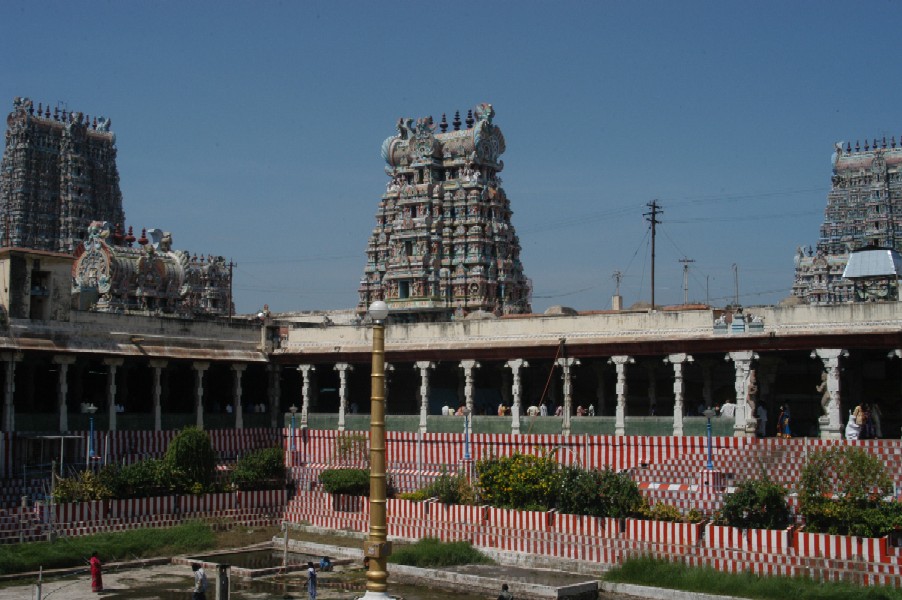 and temple together. They disappeared into the temple and are responsible for the fertility cult that surrounds the Meenakshi temple. Each night they are laid to rest together so they can couple and maintain the regeneration of the universe. and temple together. They disappeared into the temple and are responsible for the fertility cult that surrounds the Meenakshi temple. Each night they are laid to rest together so they can couple and maintain the regeneration of the universe.
As we headed towards the central shrine area we passed the entrance to Meenakshi's shrine, where pilgrims visited first. The hallway ended through a doorway, facing a large image of Ganesh. The inner shrine of Sudareshwarar (Shiva), identifiable from afar by the gold topped roof that covers that part of the temple, was a large rectangle structure surrounded by a hallway. In front of the shrine entrance the hall opened up into a large foyer that was a bustle of activity. Non-Hindus were not allowed into either of the shrines but we watched people come and go while we looked at the numerous images that adorned the foyer area in front of Shiva's place of worship. A neon sign above the entrance read "Om". A small Hanuman figure, the monkey god from the Ramayana, was popular. He was covered in red powder that people would take and use to make a mark on their foreheads. At the back of the hall was the most entertaining of the figures, images of Shiva and Kali engaged in a dance contest. Kali, the Black, is a fierce incarnation of 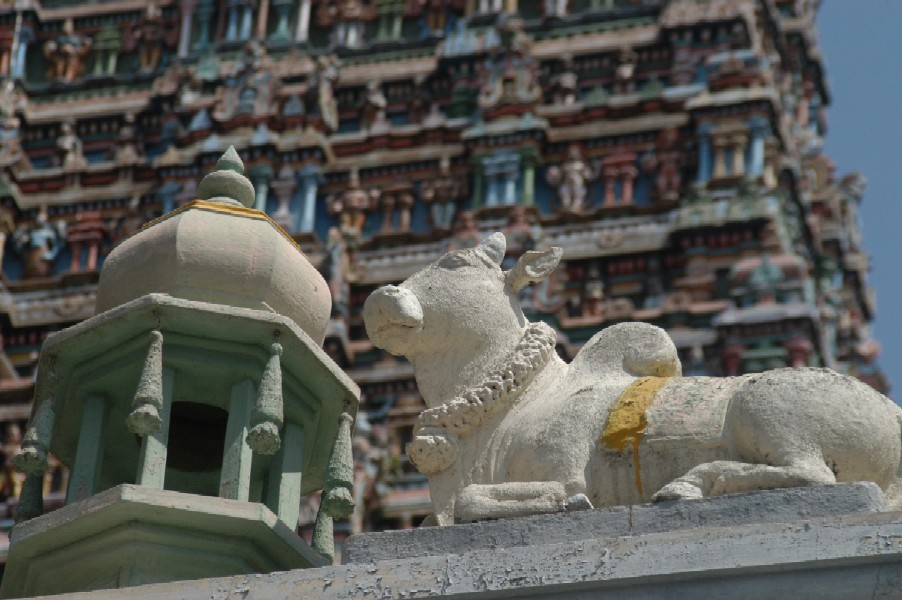 Devi with black skin and skulls around her neck. Nearby they were selling butter balls that people could purchase and throw at the two gods to cool them off. Again, I had a twinge of that amusement park feel. While meandered around the hall we observed a row of priests, shirtless men dress with dhotis, enter with trays of offerings. The priests carried rudraksha beads, a Shiva rosary, and had markings on their bodies. Three white stripes were drawn across their foreheads, arms, shoulders and chests, and a red powder dot marked the space between their eyebrows. They made a lively procession into Shiva's shrine to make their offerings. Devi with black skin and skulls around her neck. Nearby they were selling butter balls that people could purchase and throw at the two gods to cool them off. Again, I had a twinge of that amusement park feel. While meandered around the hall we observed a row of priests, shirtless men dress with dhotis, enter with trays of offerings. The priests carried rudraksha beads, a Shiva rosary, and had markings on their bodies. Three white stripes were drawn across their foreheads, arms, shoulders and chests, and a red powder dot marked the space between their eyebrows. They made a lively procession into Shiva's shrine to make their offerings.
The hustle of activity around the Shiva shrine was almost mesmerizing. It just never stopped. The odd tour group traipsing through was hardly noticed. We took a walk around the hallway that surrounded Shiva's shrine, which was quiet. There wasn't much to look at but we could sort of see into the shrine from a bared side door. Nearby was also a fresh puddle of pee, definitely the work of some desperate man from the way it sprayed up the wall. I just tried not to think about my bare feet.
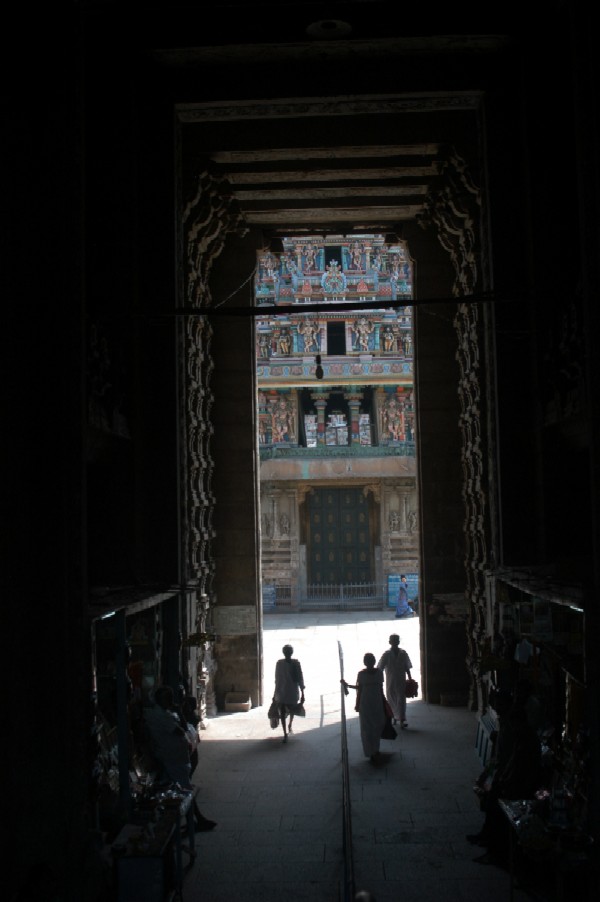 Feeling fully "templed" out for the day we didn't have the energy to wait around until the 9:00 ceremony where the two gods were bedded down together. Perhaps, we thought, we'd come back later but it didn't happen. We returned to our hotel and immediately washed our feet and got cleaned up. From the rooftop restaurant we watched the sun go down as we looked over the gopuras of the Sri Meenakshi Temple. We could hear chanting coming from the temple but were much too tired to get ourselves out again. Feeling fully "templed" out for the day we didn't have the energy to wait around until the 9:00 ceremony where the two gods were bedded down together. Perhaps, we thought, we'd come back later but it didn't happen. We returned to our hotel and immediately washed our feet and got cleaned up. From the rooftop restaurant we watched the sun go down as we looked over the gopuras of the Sri Meenakshi Temple. We could hear chanting coming from the temple but were much too tired to get ourselves out again.
|
SRI LANKA
Colombo
Oct 25
Oct 26
Oct 27-29
Nuwara Eliya
Oct 30
Oct 31
Kandy
Nov 1-5 (1)
Nov 1-5 (II)
Polonnaruwa
Nov 6
Sigiriya & Dambulla
Nov 7
Colombo
Nov 8
INDIA
Ft.Cochin
Nov 9-15 (I)
Nov 9-15 (II)
Nov 16
Nov 17-18
Madurai
Nov 19
Nov 20
Tiruchirapalli
Nov 21
Nov 22
Nov 23
Chennai
Nov 24
Nov 25-26
Nov 27-28
Ft.Cochin
Nov 29
Lakshadweep
Nov 30-Dec 4 (I)
Nov 30-Dec 4 (II)
Trans-India Train
Dec 5-7 (I)
Dec 5-7 (II)
Siliguri
Dec 8
Darjeeling
Dec 9
Dec 10-13
Dec 14
Sikkim
Dec 15
Dec 16-20
Dec 21-23
Dec 24
Dec 25
Darjeeling
Dec 26
Dec 27-Jan 2
Siliguri
Jan 3
Jaigon
(Bhutan)
Jan 4
Kolkata
Jan 5-6
THAILAND
Bangkok
Jan 6-13 (I)
Jan 6-13 (II)
Jan 6-13 (III)
|

